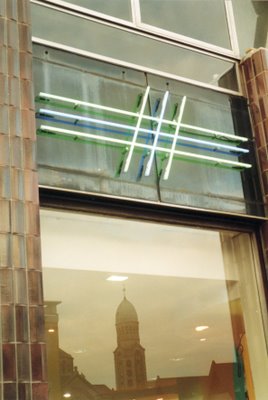

On these two photos we look at Lydéric and Phynaert the two giants of Lille, about whom there is a legend : they are the foundators of Lille. This sculpture is at the edge of the townhall of Lille.
It was rebuilt 1923 after the First World War. On the second photo there are branches of trees because I made this photo at the end of the winter. With my camera I could not make this photo with leaves on the trees, because I cannot enough far from the scupture to make the photo with leaves.
Here about the story of Lille, which was in the past not a french town.
Until 1329 it was one of the capital town of the earldom of Flanders.
In 1213 there were a siege by the French King Philippe-Auguste about what the Lillois, inhabitants of Lille, had during a long time a bad remembrance, but they had the victory so that Lille stayed flemmish.,
1369 there were a wedding between Marguerite de Flandres (Margrit of Flanders) and Philippe le Hardi, king of Burgundy, and Lille was a gift of the duke of Flanders to Burgundy (Burgundy was not France).
During the time it was Burgundy part, Lille had a very good expansion, and it was its best time. It was one of the main town for the sale of textiles. It is the traditional industry of the North of France.
1477 Marie de Bourgogne (Mary of Burgundy) was married with Maximilian of Habsbourg and Lille was a gift from the king of Burgundy to the emperor of Austria. And so went Lille to the Austrian crown.
Then came as Austrian emperor and king of Spain Charles the 5th, which french people call Charles Quint. He had the empire were "there is no sunset", it means it was always in a corner of his empire day. From the West Indies (South America) to the East Indies (India). At this time Lille was still a rich town.
Then Spain lost Austria and Lille went to the crown of Spain. Under Philipp II of Spain, it was spanish dominion, like Belgium and Netherland, but in Netherland, the Prince of Orange made Netherlands an independant country. But Lille and Belgium staid under the crown of Spain.
In 1667 was much despair in the town of Lille. In August during 10 days the king of France Louis 14th was at the doors of Lille. He held a siege of ten days and at the 28 August 1667 the Lillois gave the keys of the town to Louis 14 who came though the door of Paris in the town. He made Lille to a defensive place and gave Lille walls and a defensive system of Vauban. It was a defensive place at the border of France, so that from the time it became french Lille had to suffer under many wars. And this until 1945.
Since Konrad Adenauer and Charles de Gaulle who was born in Lille, decided to make peace between France and Germany and to make an European Community which became then the European Union, Lille had no wars more. The friendship between the two men did avoid new wars.
Perle de Rosée.





